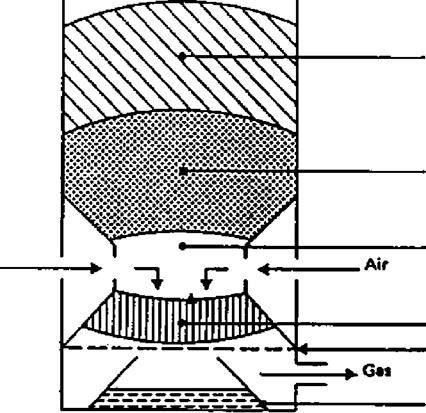 Downdraught or co-current gasifiers
Downdraught or co-current gasifiers
 |
A solution to the problem of tar entrainment in the gas stream has been found by designing co-current or downdraught gasifiers, in which primary gasification air is introduced at or above the oxidation zone in the gasifier. The producer gas is removed at the bottom of the apparatus, so that fuel and gas move in the same direction, as schematically shown in Fig. 2.8.
![]()
 Drying гопе
Drying гопе
Distillation гопе
Hearth zone
Reduction zone Grate
Ash pit
On their way down the acid and tarry distillation products from the fuel must pass through a glowing bed of charcoal and therefore are converted into permanent gases hydrogen, carbon dioxide, carbon monoxide and methane.
Depending on the temperature of the hot zone and the residence time of the tarry vapours, a more or less complete breakdown of the tars is achieved.
The main advantage of downdraught gasifiers lies in the possibility of producing a tar-free gas suitable for engine applications.
In practice, however, a tar-free gas is seldom if ever achieved over the whole operating range of the equipment: tar-free operating turn-down ratios of a factor 3 are considered standard; a factor 5-6 is considered excellent.
Because of the lower level of organic components in the condensate, downdraught gasifiers suffer less from environmental objections than updraught gasifiers.
A major drawback of downdraught equipment lies in its inability to operate on a number of unprocessed fuels. In particular, fluffy, low density materials give rise to flow problems and excessive pressure drop, and the solid fuel must be pelletized or briquetted before use. Downdraught gasifiers also suffer from the problems associated with high ash content fuels (slagging) to a larger extent than updraught gasifiers.
Minor drawbacks of the downdraught system, as compared to updraught, are somewhat lower efficiency resulting from the lack of internal heat exchange as well as the lower heating value of the gas. Besides this, the necessity to maintain uniform high temperatures over a given cross-sectional area makes impractical the use of downdraught gasifiers in a power range above about 350 kW (shaft power).